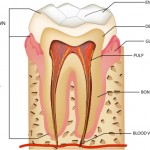
Pulpotomy is one of a number of approaches (indirect pulp capping, direct pulp capping, pulpotomy, pulpectomy) for managing carious lesions approaching the pulp of primary teeth with the aim of retaining the tooth in a symptom free state until it is lost naturally thus avoiding an extraction. Formocresol has been used for a number of years but issues have been raised regarding its toxicity. The aim of this trial was to compare the effectiveness of Calcium hydroxide [Ca(OH)2] partial pulpectomy (PP) against formocresol pulpotomy (FP) for the treatment of treatment of pulpally exposed lower primary molars.
Patient attending a paediatric dental department were randomised to randomly assigned to PP or FP treatment. All teeth were treated under local anaesthesia and rubber dam. Clinical and radiographic evaluations at six-monthly intervals were conducted by a masked investigator.
86 lower primary molars from 58 children were treated and they found:-
- The success rates for the two treatments at each 6-month interval were not different (P ‡ 0.05).
[table id=16 /]
- The most frequent failure was internal resorption, affecting five FP teeth and three PP teeth.
The authors concluded
Considering the favourable clinical and radiographic success rate of PP and the potentially toxic effects of formocresol leads us to recommend the use of PP instead of FP in primary teeth with deep carious lesions.
Related reviews and guidelines
Scottish Dental Clinical Effectiveness Programme (SDCEP) . Prevention and Management of Dental Caries in Children. Chapter 9. pages 54-57. 2010
American Academy of Pediatric Dentistry (AAPD). Guideline on pulp therapy for primary and immature permanent teeth. Chicago (IL): American Academy of Pediatric Dentistry (AAPD); 2009. 8 p. [107 references]
Nadin G, Goel BR, Yeung A, Glenny AM. Pulp treatment for extensive decay in primary teeth. Cochrane Database of Systematic Reviews 2003, Issue 1. Art. No.: CD003220. DOI: 10.1002/14651858.CD003220.
